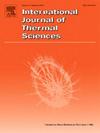Pool boiling performance enhancement using orthogonally intersecting U-grooved micro-channelled structured surfaces
IF 4.9
2区 工程技术
Q1 ENGINEERING, MECHANICAL
International Journal of Thermal Sciences
Pub Date : 2025-06-13
DOI:10.1016/j.ijthermalsci.2025.110076
引用次数: 0
Abstract
The bubble dynamics of microchannels have a direct impact on pool boiling heat transfer. The present investigation of heat transfer performance during pool boiling on three micro-channelled surfaces developed through the wire electric discharge machining process. All these developed surfaces have orthogonally intersecting U-grooved microchannels with depths of 100 μm (A1), 200 μm (A2), and 300 μm (A3). Heat transfer rates were compared to those of a bare reference surface in order to evaluate the enhancement achieved with these developed. All the experiments were performed with deionised water at saturation temperature under atmospheric pressure to get steady-state heat transfer characteristics. A hypothesis model was used to explain the observed bubble dynamics. The results showed remarkable improvements in heat transfer for all microchannel configurations as compared to the bare surface. Among them, the A2 configuration exhibited the highest performance, achieving a 171 % increase in the maximum heat transfer coefficient and a 76 % rise in the critical heat flux compared to the bare surface. The A1 and A3 surfaces demonstrated enhancements of 28 % and 76 % in HTC and 23 % and 37 % in CHF, respectively, relative to the bare surface. Furthermore, the performance of the A2 surface was found to be better compared to the data from the published literature. The superior heat transfer rates of the A2 surface can be attributed to a larger heat exchange area, increased bubble nucleation sites, enhanced macro-convection from bubble movement, and an efficient rewetting mechanism.

利用正交交叉u型槽微通道结构表面提高池沸腾性能
微通道气泡动力学对池内沸腾换热有直接影响。本文通过电火花加工工艺对三种微通道表面进行了池沸腾传热性能的研究。所有发育的表面都有深度分别为100 μm (A1)、200 μm (A2)和300 μm (A3)的u型槽微通道正交相交。将传热率与裸参考表面的传热率进行了比较,以评估这些发展所取得的增强效果。所有实验都是在饱和温度和常压下用去离子水进行的,以获得稳态传热特性。用一个假设模型来解释观察到的气泡动力学。结果表明,与裸表面相比,所有微通道配置的传热都有显着改善。其中,A2结构表现出最高的性能,与裸露表面相比,最大传热系数提高了171%,临界热流密度提高了76%。相对于裸面,A1和A3表面在HTC和CHF分别增强28%和76%和23%和37%。此外,与已发表的文献数据相比,发现A2表面的性能更好。A2表面优越的换热速率可归因于更大的换热面积、更多的气泡成核位置、气泡运动产生的宏观对流增强以及有效的再润湿机制。
本文章由计算机程序翻译,如有差异,请以英文原文为准。
求助全文
约1分钟内获得全文
求助全文
来源期刊

International Journal of Thermal Sciences
工程技术-工程:机械
CiteScore
8.10
自引率
11.10%
发文量
531
审稿时长
55 days
期刊介绍:
The International Journal of Thermal Sciences is a journal devoted to the publication of fundamental studies on the physics of transfer processes in general, with an emphasis on thermal aspects and also applied research on various processes, energy systems and the environment. Articles are published in English and French, and are subject to peer review.
The fundamental subjects considered within the scope of the journal are:
* Heat and relevant mass transfer at all scales (nano, micro and macro) and in all types of material (heterogeneous, composites, biological,...) and fluid flow
* Forced, natural or mixed convection in reactive or non-reactive media
* Single or multi–phase fluid flow with or without phase change
* Near–and far–field radiative heat transfer
* Combined modes of heat transfer in complex systems (for example, plasmas, biological, geological,...)
* Multiscale modelling
The applied research topics include:
* Heat exchangers, heat pipes, cooling processes
* Transport phenomena taking place in industrial processes (chemical, food and agricultural, metallurgical, space and aeronautical, automobile industries)
* Nano–and micro–technology for energy, space, biosystems and devices
* Heat transport analysis in advanced systems
* Impact of energy–related processes on environment, and emerging energy systems
The study of thermophysical properties of materials and fluids, thermal measurement techniques, inverse methods, and the developments of experimental methods are within the scope of the International Journal of Thermal Sciences which also covers the modelling, and numerical methods applied to thermal transfer.
 求助内容:
求助内容: 应助结果提醒方式:
应助结果提醒方式:


